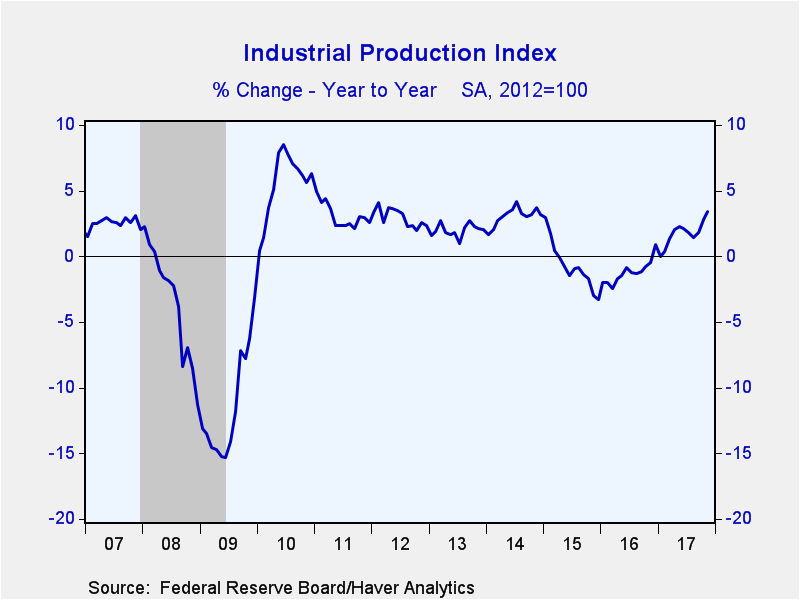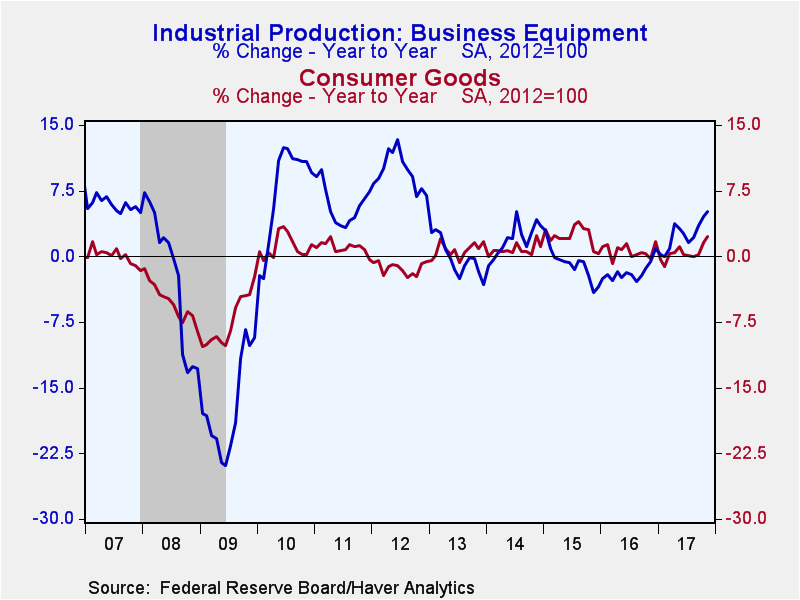 Global| Dec 15 2017
Global| Dec 15 2017U.S. Industrial Production Gain Impacted by Post Hurricane Rebound
by:Tom Moeller
|in:Economy in Brief
Summary
The Federal Reserve indicated that industrial production rose 0.2% during November (3.4% y/y) following a 1.2% October rise, revised from 0.9%. A 0.3% increase had been expected in the Action Economics Forecast Survey. The Fed [...]
The Federal Reserve indicated that industrial production rose 0.2% during November (3.4% y/y) following a 1.2% October rise, revised from 0.9%. A 0.3% increase had been expected in the Action Economics Forecast Survey. The Fed indicated that without a rebound in oil & gas extraction activity from Hurricane Nate, total November industrial production would have been unchanged.
Factory sector output improved 0.2% last month (2.3% y/y) following a 1.4% rise. The increase was led by a 0.6% increase (3.1% y/y) in production of construction supplies that followed a 0.5% gain. Output of business equipment rose 0.5% (5.2% y/y) after surging during each of the prior two months. Information processing equipment production strengthened 0.9% (2.4% y/y) after a 0.5% increase. Consumer goods output declined 0.4% (+2.2% y/y) after a 1.2% jump. Motor vehicle & parts production inched 0.1% higher (0.1% y/y) after surging in each of the prior three months. Computer, video & audio production rose 0.9% (6.3% y/y) after three months of strength, but appliance, furniture & carpeting production fell moderately (-2.0% y/y), as it has for most of the year. In the nondurable goods sector, apparel output fell 0.8% (-9.0% y/y), extending a decades-long decline. Chemical production eased 0.2% (+1.7% y/y) after a 1.1% rise. Paper production fell 1.6% (-6.4% y/y), reversing a 1.0% October rise.
Materials production rose 0.6% (4.1% y/y) after a 1.4% jump, on the strength of a 1.0% increase (3.4% y/y) in durable materials production.
In the special aggregate groupings, selected high-technology product output rose 0.3% (1.6% y/y), after two increases of roughly 1.0%. Computer & peripheral production held steady (23.7% y/y), and semiconductor and related component production gained 0.6% (0.7% y/y). Factory sector production, excluding the auto & high-tech sectors, increased 0.2% (2.6% y/y) following a 1.5% rise.
Capacity utilization rose to 77.1% from 77.0%, its highest level since April 2015. Factory sector utilization strengthened to 76.4%, its highest point since May 2008. Total factory sector capacity rose 0.7% y/y.
Industrial production and capacity data are included in Haver's USECON database, with additional detail in the IP database. The expectations figure is in the AS1REPNA database.
Workforce Development in Today's Economy from Fed Governor Lael Brainard is available here.
| Industrial Production (SA, % Change) | Nov | Oct | Sep | Nov Y/Y | 2016 | 2015 | 2014 |
|---|---|---|---|---|---|---|---|
| Total Output | 0.2 | 1.2 | 0.3 | 3.4 | -1.2 | -0.7 | 3.1 |
| Manufacturing | 0.2 | 1.4 | 0.2 | 2.3 | -0.0 | 0.1 | 1.2 |
| Consumer Goods | -0.4 | 1.2 | 0.0 | 2.2 | 0.6 | 2.3 | 0.8 |
| Business Equipment | 0.5 | 1.2 | 1.5 | 5.2 | -1.8 | -0.9 | 1.9 |
| Construction Supplies | 0.6 | 0.5 | 1.9 | 3.1 | 1.3 | 0.5 | 3.4 |
| Materials | 0.6 | 1.4 | 0.0 | 4.1 | -2.3 | -1.4 | 5.1 |
| Utilities | -1.9 | 2.0 | -1.3 | 2.3 | -0.3 | -0.7 | 1.4 |
| Mining | 2.0 | -0.6 | 1.7 | 9.4 | -9.1 | -4.3 | 10.7 |
| Capacity Utilization (%) | 77.1 | 77.0 | 76.2 | 75.5 | 75.7 | 76.8 | 78.6 |
| Manufacturing | 76.4 | 76.3 | 75.2 | 75.1 | 75.1 | 75.5 | 75.4 |
Tom Moeller
AuthorMore in Author Profile »Prior to joining Haver Analytics in 2000, Mr. Moeller worked as the Economist at Chancellor Capital Management from 1985 to 1999. There, he developed comprehensive economic forecasts and interpreted economic data for equity and fixed income portfolio managers. Also at Chancellor, Mr. Moeller worked as an equity analyst and was responsible for researching and rating companies in the economically sensitive automobile and housing industries for investment in Chancellor’s equity portfolio. Prior to joining Chancellor, Mr. Moeller was an Economist at Citibank from 1979 to 1984. He also analyzed pricing behavior in the metals industry for the Council on Wage and Price Stability in Washington, D.C. In 1999, Mr. Moeller received the award for most accurate forecast from the Forecasters' Club of New York. From 1990 to 1992 he was President of the New York Association for Business Economists. Mr. Moeller earned an M.B.A. in Finance from Fordham University, where he graduated in 1987. He holds a Bachelor of Arts in Economics from George Washington University.










